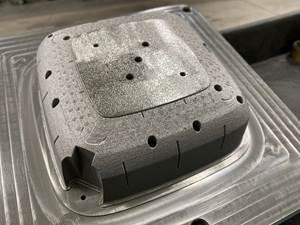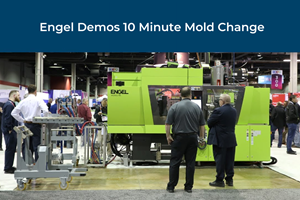How to Advance Molding Undercuts with Collapsible Core Design
A new flush-style collapsible core design might help to overcome objections to using the technology and advance the molding of undercuts.
Collapsible cores have long been touted as a viable alternative for molding undercut details like internal threads as opposed to using traditional unscrewing mechanisms like racks and gears. Several potential benefits result from using collapsible cores, not the least of which is eliminating the messy unscrewing cores, and yet it can be difficult convincing a moldmaker or a molder to use the technology. A new flush-style core design just might help to overcome objections and advance the molding of undercuts.
Here are seven good reasons to consider this new technology:
- Durability. The most common objection is that the cores do not have the durability to last three million cycles. In some cases, this might be true, but the patented flush-style core has succeeded in attaining eight to 10 million cycles. For example, flush-style cores were used for a 24-cavity tool molding a wine cap measuring 30 millimeters by 40 millimeters. The cap’s wall thickness reduces to 0.25 millimeters for the tear-off strip. There are pin shut-offs on both sides of the core, and the slides shut off on the core, which shapes the bottom of the cap. The mold ran for eight years and averaged between one million and 5 million cycles per year.
- Radius positioning. This project was successful because unlike other styles of collapsible cores, the radius on a flush-style core (located on its pin) is positioned internally versus at the core’s tip. This is so that the pin’s top surface is flush with the core’s top, enabling the part to be designed with a consistent wall thickness.
- Ring design. Also unique is that the inner and outer fingers of the flush-style cores are positioned on two separate rings versus one. Wire EDM improves the fit between the fingers, and all the fingers open independently so that the sides of the fingers do not wear.
- Core assembly. The core assembly uses straight, true diameters, further improving the fit and core durability and accuracy. These true diameters act like a pin and bushing with almost no wear.
- Core fit. Working without tapered-fit surfaces makes it easier to fit the core into the mold. A straight pin ensures that the core is open to the proper molding position, so the molded part shows only a witness line and no flash. This new fit also improves thermal transfer by fitting a true diameter.
- Cost and cycle time. A collapsible core design can help mold parts with undercut details at one-third the cost of an unscrewing mold and half the cycle time. It is no longer necessary to design in a rack mechanism because there is no need for it because of the cost reduction coupled with a simpler mold design. The notably faster cycle time is achieved because there is no unscrewing of the part.
- Footprint. A final point to consider is that collapsible cores have very small footprints, which means that the designer can position more parts in the same size mold or the same number of parts in a smaller mold using a smaller press. When compared to an unscrewing mold, the difference is dramatic, as cavitation can be increased by a third or even half again as much in the same size mold.
About the Contributor
Garry Zydron
Garry Zydron is the president of Collapsible Core Inc.
Related Content
A 3D Printing Retrospective
A personal review of the evolution of 3D printing in moldmaking throughout the past 25 years.
Read MoreWhat is Driving Mold Lifecycle Management Digitalization?
OEMs are looking to partner with suppliers to share and track data across the supply chain for advanced intervention and process management.
Read MoreVIDEO: How to Change Out Molds in 10 Minutes or Less
Is a 10-minute mold change possible? Check out this demo to see how it can be done.
Read MoreHow to Supply Cooling to Additive Tooling
Additive tooling provides limitless options for cooling a mold’s difficult-to-cool areas.
Read MoreRead Next
Top 10 Game-Changing Technologies
As part of our 20-year anniversary, readers share their top most impactful technologies since 1998.
Read MoreAre You a Moldmaker Considering 3D Printing? Consider the 3D Printing Workshop at NPE2024
Presentations will cover 3D printing for mold tooling, material innovation, product development, bridge production and full-scale, high-volume additive manufacturing.
Read MoreHow to Use Continuing Education to Remain Competitive in Moldmaking
Continued training helps moldmakers make tooling decisions and properly use the latest cutting tool to efficiently machine high-quality molds.
Read More







.png;maxWidth=300;quality=90)




.jpg;maxWidth=300;quality=90)
_300x250 3.png;maxWidth=300;quality=90)








